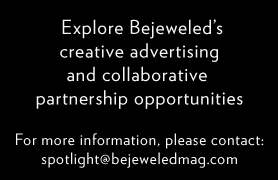Meet Alexandra Hutchings. owner of Metier Paris and her exceptional Antique Jewels
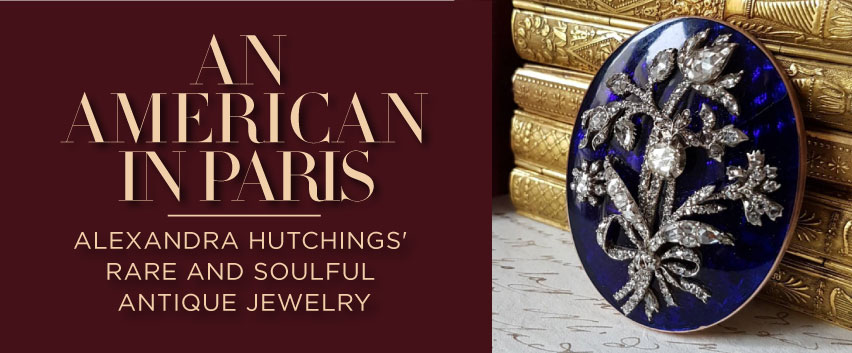
When you scroll through American born, Paris-based Alexandra Hutchings owner of Métier Paris’ website or Instagram feed, you immediate get a feeling that there is more than meets the eye. Her uncanny sense of what is rare, soulful and beautifully crafted are right there for you to see in her skillfully curated collection of jewelry that spans from the Georgian through Art Deco Eras. But there are also pieces that tug at your heart, that not only reveal the character of the jewels and their different lives but gives a glimpse into spirit, strength and passions of Alexandra herself.
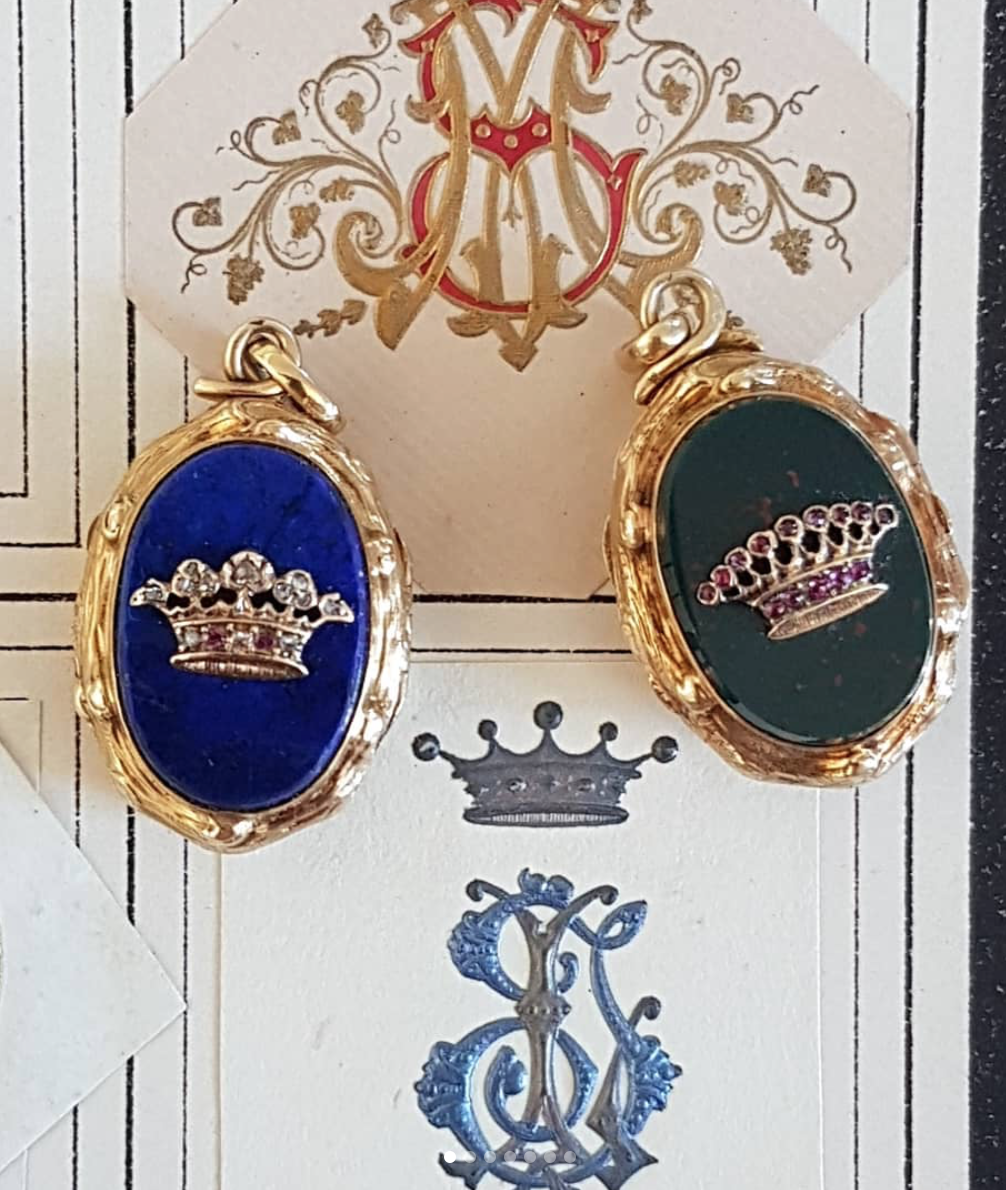
Two gemset lockets: lapis set with diamonds (L), and blood agate set with rubies (R)
“My life and career took many twists and turns before I settled into world of antique jewelry,” Alexandra explains. Originally from Washington D.C., she went to boarding school on the East Coast, and spent part of her youth on her family’s property in New Mexico. Her summers and vacations were spent in France where her great grandparents lived, and maternal grandmother was born and was part of the art and literature scene in Paris in the 1920s. “I spoke French as a first language which was a family tradition and went on to studied photography at Parson’s School of Design. My fascination with jewelry started very young and during school, I was lucky enough to land a summer job at Tiffany & Co. But I was unsure if I could turn my passion into a career and abandoned it for a position in tech and finance and worked in Silicon Valley until the tech bubble burst and I knew I had to start over.” Alexandra explains.
Here Alexandra talks candidly about the different paths she took on her road to finding her way back to her first love, jewelry, how building Métier Paris “kept her heart and soul alive while going through challenging times” and how she found happiness and made Paris ‘home’ for herself and daughter Sophie.
Can you tell us a bit about your family’s ties to France?
“My American great-grandparents moved to France in1901. Some family members founded the American Hospital in Paris. My maternal grandmother was born in France close to the Italian border. She went to Vassar and became an actress on Broadway in the 1920s. After the crash of 1929, she returned here to live with her my great grandmother, joined the art and literature scene and dated Alexander Calder. She was friends with Kandinsky, Henry Miller and Anais Nin to name just a few. When the war came to Paris, she moved to New Mexico and my grandmother became active in the war effort and was later awarded a medal of honor by Charles de Gaulle. We lived in Cannes for a brief period in 1972 while my father travelled as an Advance Man for the White House. And then as you mentioned, I was raised speaking French as a first language, and spent much of my childhood in France.”
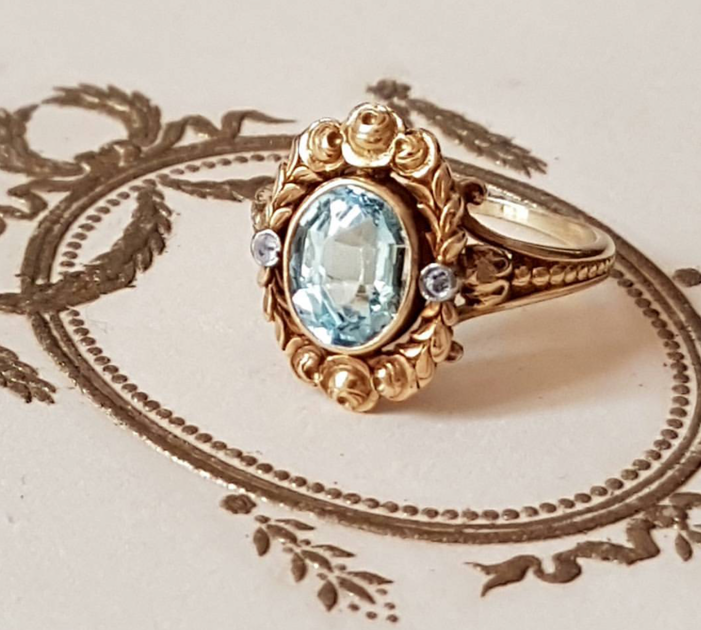
Edwardian aquamarine ring, circa 1910
When did you first feel an affinity for jewelry?
My love of geology began as a child, hunting for stones and arrowheads on our family property in New Mexico, where I collected beads and precious little odds and ends. My mother had an amazing collection of antique jewelry that she inherited, and I would spend hours and hours going through all of the pieces, trying them on and taking in their beauty. This all led me to landing the summer job at Tiffany& Co.in New York and where I learned about stone setting, lost wax casting and quality assurance.”
Although you have a deep passion for jewelry, you change to a different career path, can you tell us why?
“I didn’t have a clear direction as how to make my dream of working in jewelry a reality and I needed a job. I fell into high tech project management, a path I stayed on for nearly a decade. In 2001, after the tech bubble burst, I fell in love with a Frenchman and wound up moving to Paris to be with him. I wasn’t allowed to work, and I enrolled at the Sorbonne, but I became increasingly bored and lonely. When he and I split up, I returned to the U.S. and began training as a bench jeweler. I found working with gold to be very rewarding, but I fell in love again and married. I became content and more at ease but then I tragically lost my son in childbirth. I became adrift and despondent and followed where my husband led. One day he came home and announced we were moving for his career back to ….Paris.”
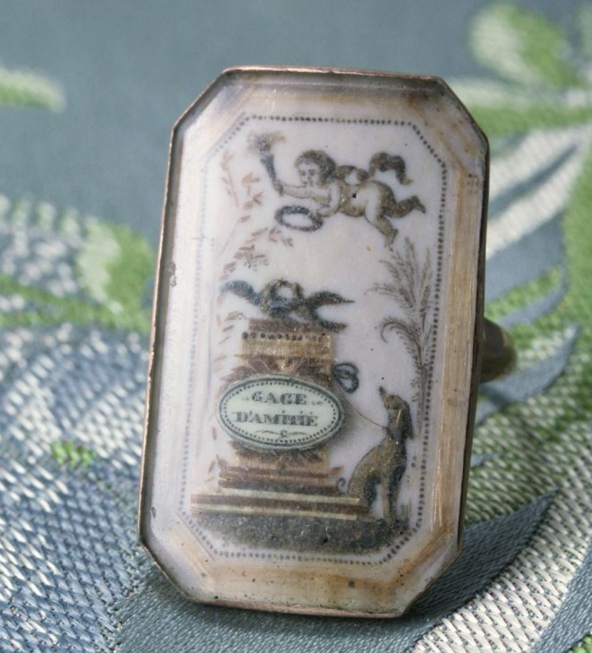
French 18th century sentimental ring, “A Token of Friendship”
Is that when you started working again with jewelry?
“Yes. My previous experience taught me that it’s very important to have a reason to bound out of bed in the morning. Being an expat spouse is very difficult, as we are not allowed to work. Often one’s self-esteem and marriage suffer. Mine began to. My husband traveled six months out of the year and I knew. I needed a new plan to feel good about myself.
All of my background, my love for jewelry, my stint at Tiffany and Co., my training as a bench jewelry and my photography background all came together, and I launched my website.
As my business took off, I knew that my marriage was failing, and it was time to get out, but due to my immigration status I had to wait four years before I could file for divorce or I would have been deported without my daughter who was 14 months at the time. My business kept me sane and gave me the ability to face the more difficult times I was experiencing. As I became more familiar with the landscape of internet sales, Instagram and all the facets of buying and selling antique jewelry, I felt a weight lifted and a true sense of happiness about myself, my life and career.” It became an exhilarating time.”
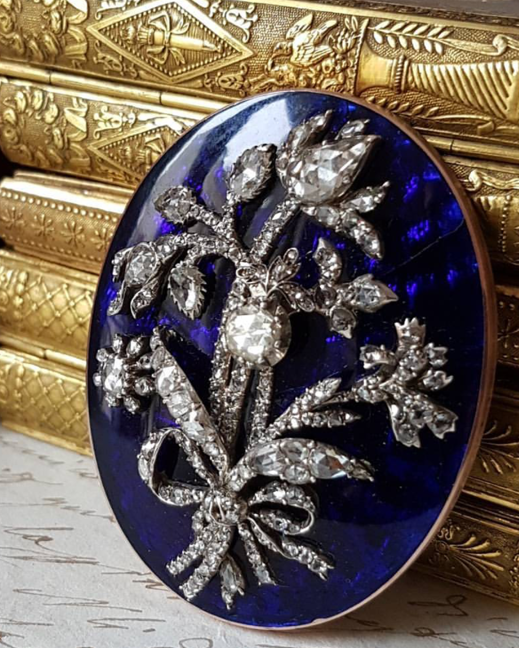
A Georgian enamel and rosecut diamond plaque, circa 1780
Let’s get down to the rare and exceptional jewelry you choose, what are your favorite time periods?
“There are many! My first love of jewelry came from discovering bloomed gold, which is emblematic of late Victorian English and American pieces, especially gem-set lockets, for which I will always have a weakness. I love rings from the Grand Tour era, when 18th century young men would buy Roman intaglios and cameos and have them set into rings. I also have a penchant for Egyptian revival pieces, when well done. One of my other favorite periods and styles is 18th century Iberian jewelry.
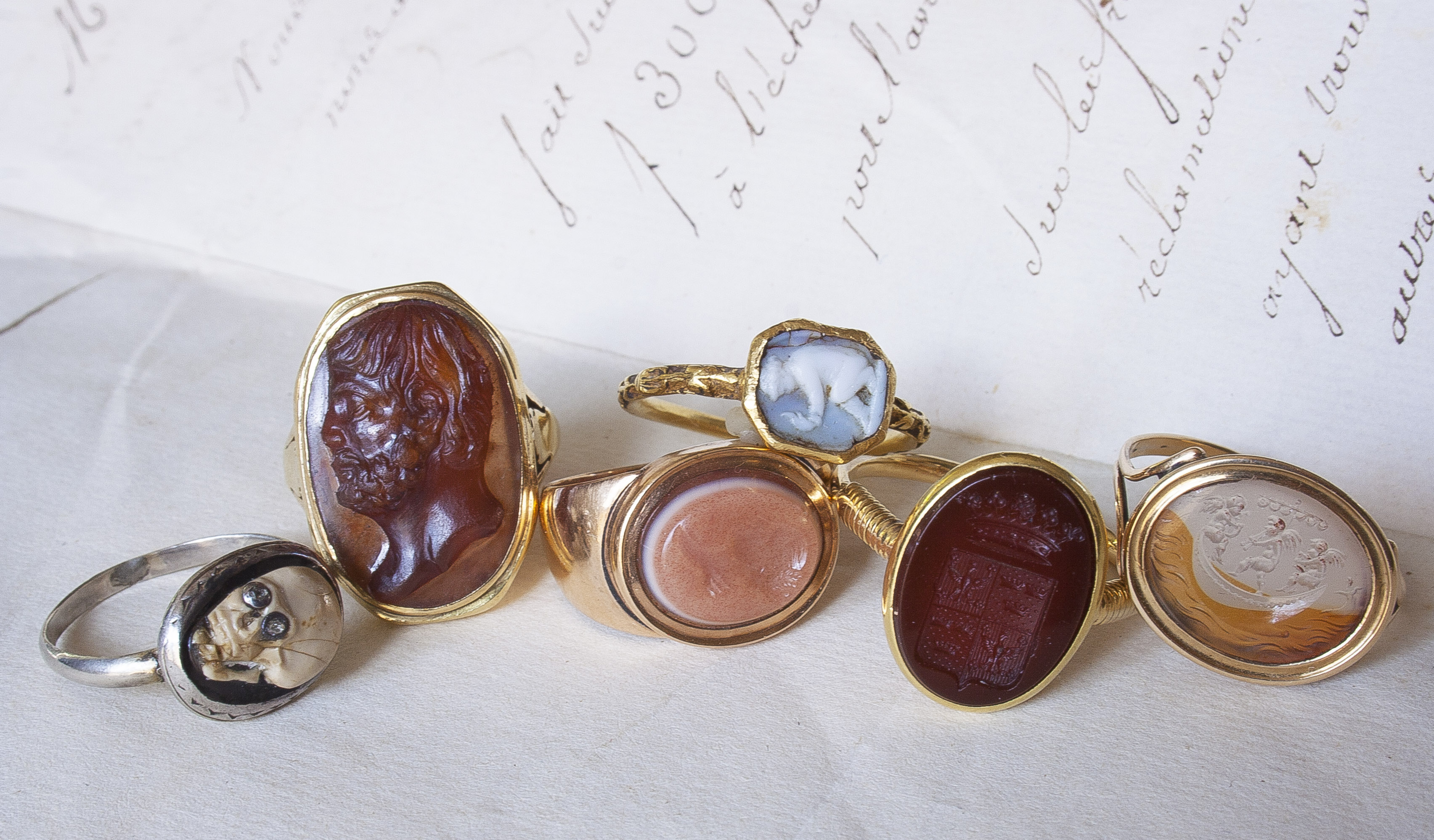
Collection of antique cameos and intaglios: 17th c skull ring, 17th century cameo ring, gold Grand Tour ring with ancient Roman intaglio, 17th c ring with Roman cameo, armorial signet ring c 1830, Italian intaglio ring c 1800.
But the list goes on: There’s romance in finding a four hundred year old piece that’s either been loved and worn for centuries or, better still, sitting in a drawer unworn. The Cheapside Hoard is a huge favorite. I was thrilled to meet Hazel Forsyth and to be included in the acknowledgements of her book, London’s Lost Jewels.”
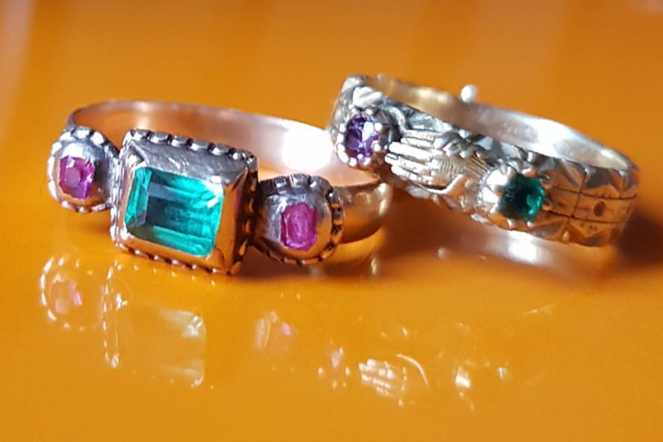
A 17th century ruby and emerald ring, an 18th century ruby and emerald fede ring, opens to reveal two hearts
You have an amazing eye for awe inspiring representations of different periods. Do you ever find it difficult to part with certain pieces?
“Some are just so unique, so rare, that I know I’ll never find another. This is especially true of Georgian jewelry. I recently sold a terrific white enamel English mourning ring set with a large amethyst and diamonds, dated 1774 on the band. That was tough to let go. Additionally, I almost kept a mid-18th century emerald and diamond pendant with a miniature of cherubs as explorers, a pair of Iberian emerald “lazo” earrings, a seditious ring with a pop-up Napoleon, an 18th century “flaming heart” diamond ring that had never been sized. But I’ve chosen to make this my business. I have to keep a professional distance to avoid getting attached, otherwise I’ll never sell anything. I never wear any of the pieces on offer, except around the house from time to time to make sure they’re comfortable. I have bills to pay, and the more keep finding exceptional pieces, the desire in me grows to find those that are even more extraordinary, so I have to keep the churn going.
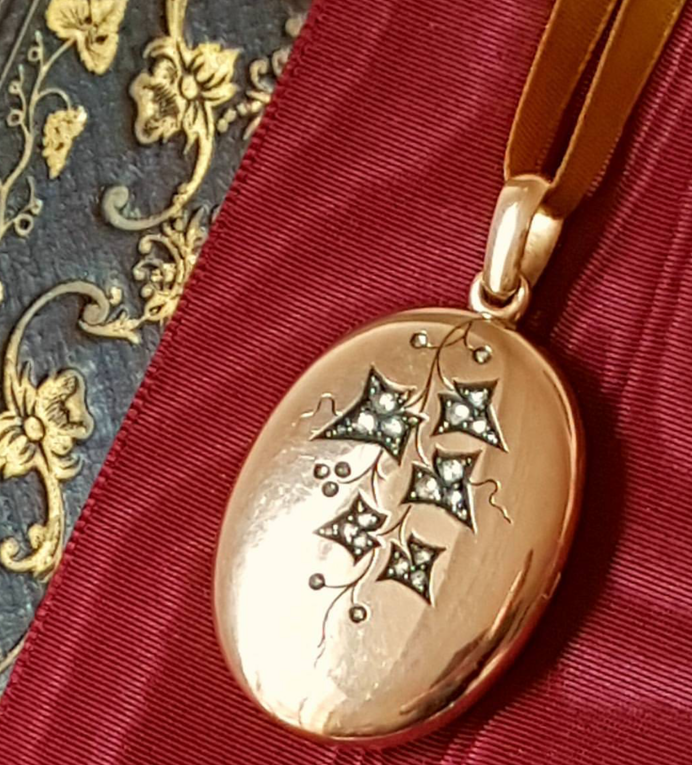
Rose gold locket with diamond ivy motif, late 1800s
The hardest is ‘letting go’ of pieces I lose when bidding at auction. It’s important not to get your heart set on anything before the pound of the gavel, but I recently lost out on a rare Moishe Oved owl ring, and an authentic 18th century enameled Memento Mori skull ring. Those losses hurt because they’re so singular and so infrequently found.”
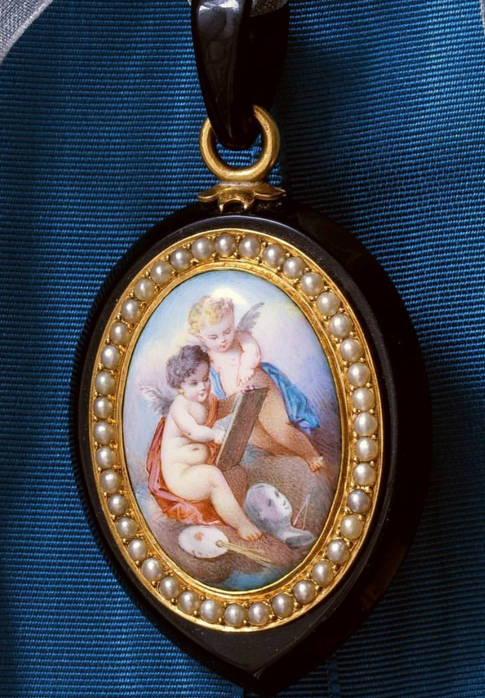
Whitby jet pendant with enamel miniature of cherubs, English 1860s
What do you look for in the pieces you choose?
“Quality, condition and authenticity first; if the piece is also rare or at least uncommon, even better. After that, it has to speak to me, it has to be appealing and practical to wear. Anything figural, anything that reflects an historical figure, a Greek god, a beloved animal, or expresses a sentiment either of love or remembrance hits me a gut level. Most of all I look for the human touch in meaning, in workmanship and design. These element stands the test of time and are appreciated today. I also pay attention to the market and what my clients are buying and wearing, that helps me hone in on pieces I might otherwise skip.”
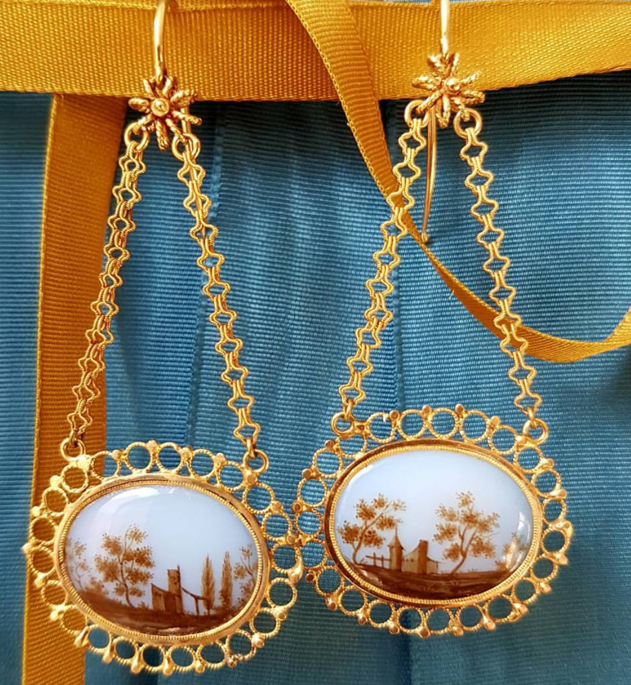
French Empire era gold and opaline glass earrings
Do you have any advice for novice collectors who are just beginning to purchase antique jewelry
“Handle as many pieces that you can, regardless of whether or not you plan to buy them or can afford them. This helps to train not only your eyes but your hands as well so that when you’re ready to purchase you can feel confident in your choices. Good antique jewelry has a specific feel, which differs from era to era, and you won’t learn that ‘feel’ unless you touch as much as possible. If a piece doesn’t seem right, if it’s the wrong weight and feel for the era it was supposed to be made, then I know right away to skip it. I check for mismatched styles that can indicate a bad adaptation, as well as repairs and stone replacements. Brassy gold with no patina and poorly cut and set diamonds are a dead give-away,
If you see the same style of piece over and over such as Saint Esprit pendants, flaming heart rings and giardinetti rings, they are usually reproductions from Turkey or India. The fakes I see most are lover’s eye and Memento Mori jewelry because those are so rare. I tend to stay away from Art Deco jewelry since it’s the most reproduced and the hardest style to spot reproductions. Another tricky area is 19th century reproductions of 17th century jewelry, especially rings, that people believe are the real thing but aren’t.
You should read, read, read. Look at lots of photos. Follow serious dealers on Instagram who have been in the business for at least a decade and have stellar reputations. Ask them what makes a piece authentic.”
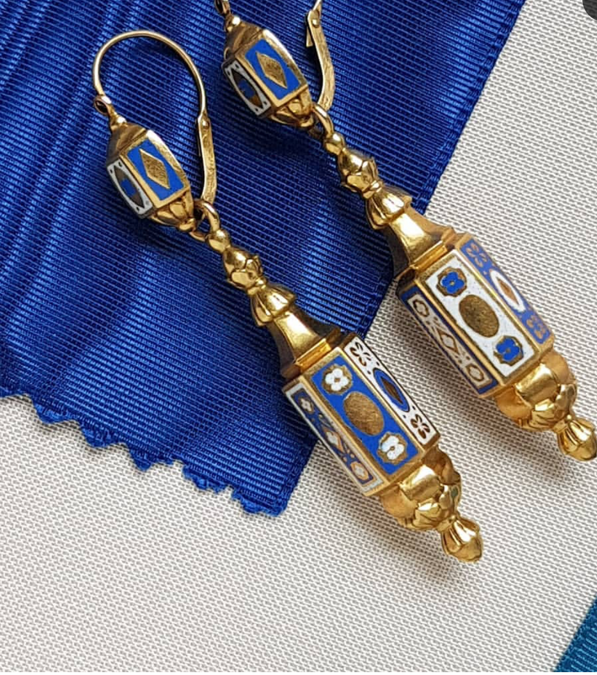
Belgian blue and white enamel torpedo “day/night” earrings, circa 1840
How do you research your jewelry?
I read copiously, study photographs and museum collections, and handle as many pieces as I can. I have an extensive library of books in many languages. I can’t speak most of these languages but can muddle my way through texts and photo descriptions. I think it’s important not to avoid great material simply because you can’t read the language.”
Can you let us in on what pieces comprise some of your personal jewelry collection?
“I don’t wear a lot of jewelry in my day to day life, just a pair of diamond studs my husband gave me when we were first married. I’ve kept my Art Deco diamond and sapphire engagement ring for my daughter. I have a magnificent Marcus & Co. Art Nouveau locket that belonged to my great-grandmother, which my mother gave to me on my wedding day, plus some great vintage costume pieces that belonged to my grandmother. I love having the styles of multiple generations of women in my family.”
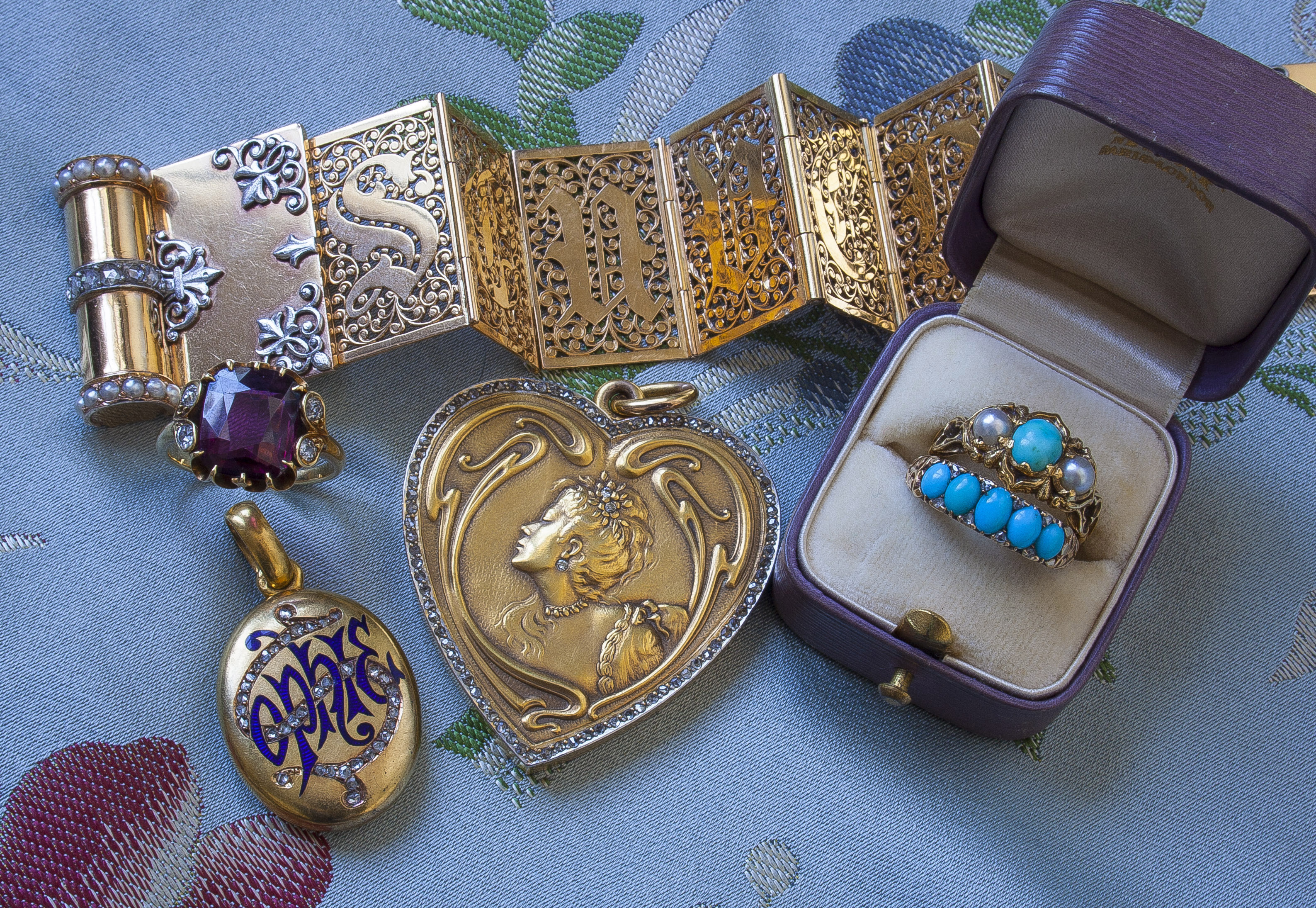
Alexndra’s personal pieces, with the exception of the Souvenir book bracelet, which is for sale): An almandine garnet ring, Art Nouveau locket and turquoise rings from my great grandmother, plus an Art Nouveau locket spelling “Sophie” that I found for my daughter.
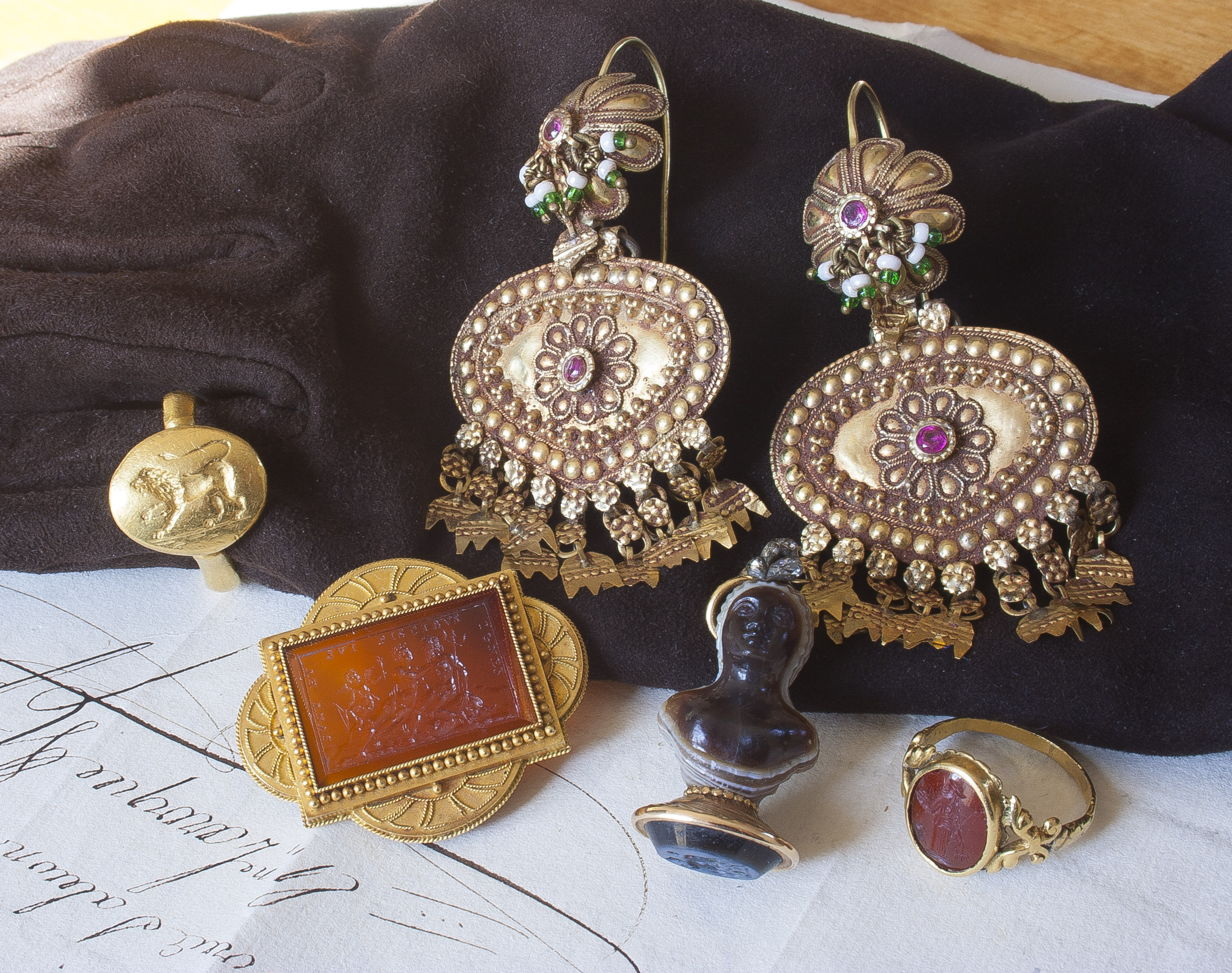
More of Alexandra’s personal pieces, from left to right) Ancient ring with lion (assumed Achaemenid 4th c BC), 18th c intaglio of Aphrodite and Poseidon with cupid, engraved in Latin “Even fishes have their fires”, in a 19th c setting; antique Indian earrings, agate blackamoor pendant with Roman intaglio c 1720, 18th century ring with Roman intaglio 2nd century AD.
“Pieces that I’ve kept that I was originally going to sell (at least for now ) include a Blackamoor agate pendant with ancient Roman intaglio, a pair of large gold and ruby antique Indian earrings, an 18th century intaglio of Aphrodite and Poseidon in an archeological style gold setting, and a gold ring engraved with a lion from the 4th century BC, because I’m a Leo. Plus it’s awesome.”
Do you travel often and where do love to travel ?
“I would love to travel a lot more, but being a single mom keeps me at home, my daughter’s dad is a consummate world traveler and she lives with me most of the time. France is a great home base for visiting places we could never see otherwise. We’ve been to Madeira, Morocco and the Seychelles. I go to Greece and Italy fairly often. I love anyplace that has an ancient culture, great art, architecture, food, and shopping. Sun and beach are a bonus. A few years ago I found an obscure beach town in Turkey with ancient ruins and a spectacular coastline, I can’t wait to return. I backpacked through Java and Bali in 1992, I’m planning to take my daughter for my 50th birthday next summer.”
Are you happy that you have made Paris your home?
“Yes there is great cheese and affordable healthcare. Joking aside, after a couple of challenging times here, it has become home and moving would involve not just me but my daughter and ex-husband, who have their own lives here. France has been a part of my family’s history for more than a century. Now, my daughter is a fifth generation expat. She’s having a really wonderful upbringing here that she wouldn’t have in the US. And, after all, it is the city of romance—for me that means the allure of continuing to find amazing jewels.”
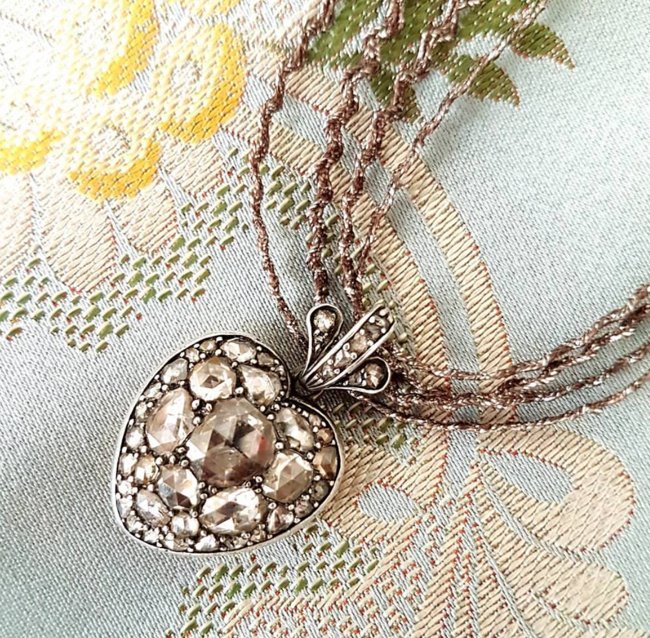
A rare 18th century rose cut diamond heart locket
.




